Exemplification for foundation subjects
Religious education exemplification standards file level 6
Pupil's profile
Pupil D is a high-achieving pupil who has a good conceptual understanding of religious ideas. She likes to use her own time to read about and discuss topics in depth. She works methodically and is keen to link what she learns about religion to her own viewpoints and insights.
Evidence groups
Questions of meaning in life: does life have a purpose?
Context
Pupils began by recording some reflections on the question of meaning in life, then took account of the way claims to meaning in life are challenged by the seemingly meaningless suffering caused by natural disasters. Each pupil chose a picture about suffering and reflected on it for a short time before writing down all the questions raised by their chosen image.
This activity prepared pupils for the philosophical and practical considerations of Buddhist and Christian teaching about suffering, theodicy and questions about God and evil, which they carried out in the following lessons.
Pupil's work
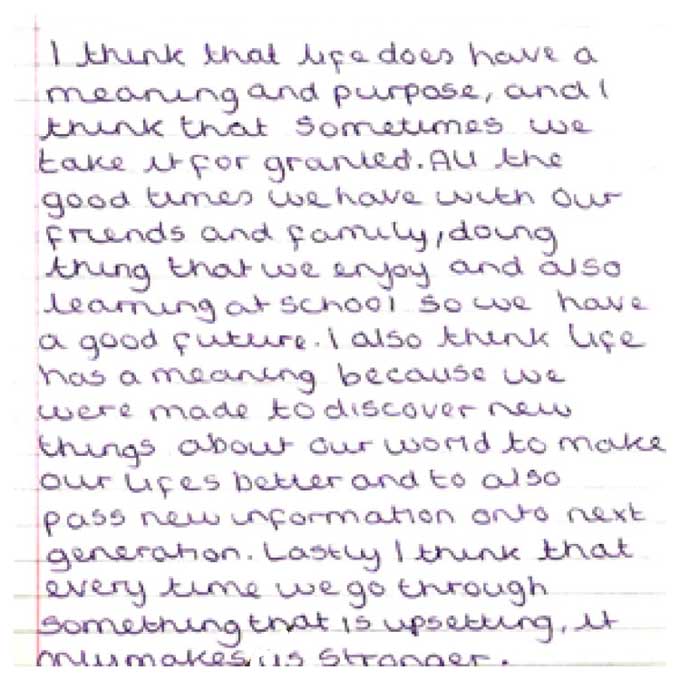
Thoughts on whether life has meaning
Pupil D's insights are based on class and paired discussions. She made useful contributions to the discussions and adapted her ideas as a result of what others said.
Thoughts on class discussions
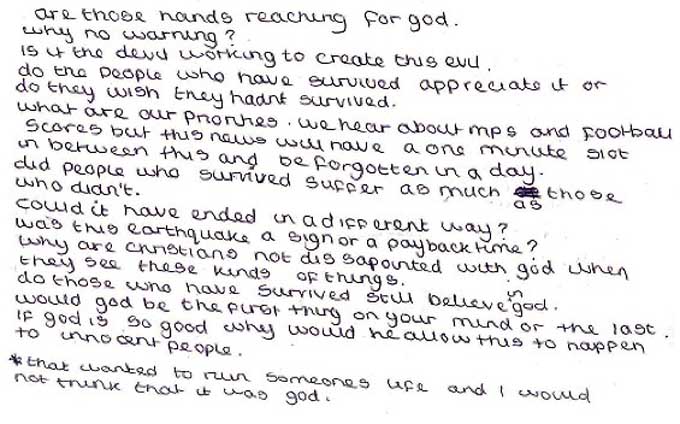
Pupil's list of questions
Pupil D chose a picture of earthquake survivors. She raised questions about religious issues related to evil and suffering.
Next steps
To progress, Pupil D needs to:
consider Buddhist concepts of right living, which will enable her to analyse her initial ideas on the meaning of life and the challenges of suffering
explore how some religions respond to the problem of evil and suffering, using sacred text and other sources
explore philosophical arguments around the problem of evil and suffering.
May I be a protector to the helpless?
Context
This was the second activity in a unit of work about Buddhism and the life of Aung San Suu Kyi. Pupils learnt about the Nobel prize winner and how in 1999 she chose to stay in Burma rather than return to her family home in Oxford to spend time with her terminally ill husband. In groups, pupils discussed and ranked nine pieces of advice. They then studied the Noble Eightfold Path and a selection of Buddhist meditation texts before forming their own view about Aung San Suu Kyi's actions. The use of a dilemma encouraged pupils to explore diverse views in depth.
Pupil's work
Assessment Commentary
Pupil D has explained the profound religious, social and personal challenges that Aung San Suu Kyi has faced and used examples to explain the relationship between Buddhist teaching and a global issue.
Thinking about religion and belief:
Pupil D's essay shows she can express insights into some of the challenges of being committed to a religious path in the contemporary world. She uses her interpretation of the Nobel Eightfold Path (right livelihood, right mindfulness) to explain the Buddhist teaching (dharma) that guided Aung San Suu Kyi. She also describes Aung San Suu Kyi as 'a lamp to people in darkness' and relates this to the concept of 'making every effort to do good to others', her understanding of 'right effort'. Pupil D clearly understands the concepts of Buddhist teaching, inspiration, having faith in others and the metaphor of 'light in the darkness'. This gives weight to her explanations of her own responses.
Enquiring, investigating and interpreting:
The key forms of religious expression that Pupil D uses in this work are the Noble Eightfold Path, Buddhist sacred text and the expression of commitments in action by Aung San Suu Kyi. She has given insightful interpretations of the relationship between Buddhist sacred text and Aung San Suu Kyi's actions, for example she has written: 'she was strong to be a servant to the world, because it was such a hard thing to do'.
Reflecting, evaluating and communicating:
Pupil D has used the concepts of Buddhist living and her own interpretations to explain the intertwined religious, political and personal challenges that Aung San Suu Kyi faced. She has used the human rights struggle for democracy to question the social and political impact of Buddhist teaching in the contemporary world. She has also considered how Buddhist teaching (from Bodhicaryavatara chapter 3) sheds light on the dilemma and the religious, personal and social challenges of following the religion.
The task prompted Pupil D to express her own aspirations, values and commitments, for example she would like to be 'a protector' and 'a lamp in people's darkness' but not 'a servant to the world'. She has clearly recognised the extraordinary strength of Aung San Suu Kyi and expressed both sides of the dilemma. In the final paragraphs of her work, she struggles with the dilemma. Overall, however, her work is a persuasive argument for the views she presents.
Next steps
To progress, Pupil D needs to:
explore in more depth and evaluate the impact of religion on beliefs and personal attitude, for example by considering the fact that the military junta in Burma includes people who practice Buddhism
interpret the varied social and political consequences of commitment to Buddhist teaching
explore another example of someone who has struggled for human rights based on another religion or belief and compare the two.
Why do people suffer?
Context
Pupils were shown 22 triptych images, with no words, created by the artist Si Smith depicting the story of Job from the Jewish and Christian scriptures. They were not told the story and instead were asked to reconstruct it from the images, highlighting the questions that the images raised about God, evil, suffering and disasters.
Pupil's work
Assessment Commentary
In her story, Pupil D has expressed the arguments through those who try to comfort Job.
Thinking about religion and belief:
Although some of the details of Pupil D's story are inaccurate, she is very aware of the philosophical issues behind the story of Job. For example, she considers whether suffering is a payback for evil done and whether God is silent in the face of human suffering and loneliness. She has examined some ideas about hell, forgiveness and the awareness people may have of wrong doing. Through exploring these ideas, she has shown she understands the challenges that suffering and natural disasters present to those who believe in God.
Reflecting, evaluating and communicating:
Pupil D has addressed religious and spiritual questions about the challenge of suffering and the belief that God is good or that the innocent will live with goodness. In her conversation with the teacher, she has explained some of the reasons why suffering might be allowed by a good God: to strengthen, to enable empathy, to test a believer. At the end of the story, she has expressed the challenges of the problem: 'Job searches for meaning in his pain and suffering...he had to go through suffering so he could see the way others feel...'. Her insightful responses have shown she has clearly understood the 'visual text'.
Next steps
To progress, Pupil D needs to:
consider the problem of innocent people suffering
develop her understanding of philosophical arguments about beliefs 'for and against' the goodness of God in the light of her understanding of evil.
Why does God pick on the innocent?
Context
Pupils explored different perspectives on suffering and evil. They recorded their arguments for and against God being responsible for evil. Then, using a writing frame, pupils raised a number of questions on the earthquake in China and provided answers to three questions from a Christian, an atheist and their own point of view.
Pupil's work
Assessment Commentary
Pupil D explains some reasons why Christians and atheists disagree about God and suffering, using her arguments to address ultimate questions.
Thinking about religion and belief:
She has shown that she can explain views from different perspectives. By providing her own answers in the final column of the third piece of work, she has shown that she can bring together ideas from different sources. She has also developed her own questions based on work in previous lessons, for example 'Why does God pick on the innocent?' relates to work on the story of Job. She has clearly expressed her idea of a Christian response: 'He tries to teach us the values of life...when we suffer, we learn the meaning of happiness.' She has provided atheist views to contrast with the Christian responses, for example: 'suffering and evil comes from real human beings and the way they act in the world and the choices they make.' She has used a variety of arguments to consider ultimate questions.
Reflecting, evaluating and communicating:
Pupil D has handled the diverse views effectively by keeping them clear and separate. She has also successfully provided her own views. Her ability to handle the ideas of atheists (with whom she largely disagrees) is not as confident and detailed as her ability to handle Christian views (with which she often agrees). However, when she writes 'God does not exist - tragedies have nothing to do with God, if a tragedy happens then it is because of a scientific problem with tectonic plates', she has used scientific explanations and rational starting points to articulate an atheist viewpoint.
Next steps
To progress, Pupil D needs to:
explore reasons why diverse views exist.
Is there an evil force in the universe?
Context
Pupils explored the story of Geneses 2-3 (story of the fall) focusing on the symbolism of the tree, serpent and choices. Martin Luther's idea, that 'each of us is Adam to our own soul' suggested to the pupils that the story symbolises choices between good and evil for any person. They created an image to reflect the meaning of the story. Through written work, they suggested how Christians and atheists might interpret the symbolism of features such as a watching God, an evil serpent, temptation and a moral choice.
Pupil's work
Assessment commentary
Pupil D interprets the story from different viewpoints. She enquires into and explores responses to the ultimate questions: Where does evil originate? How can we explain suffering?
Thinking about religion and belief:
Pupil D has used religious and philosophical concepts to enquire into and interpret different views on the source of evil and has successfully handled different perspectives. For example, from a Christian viewpoint she has written 'the snake represents the evil force. The evil forces that it could be representing in the world today could be the devil, because he is someone that tries to overpower God and cause evil...'. From an atheist viewpoint: 'suffering comes from the heart of human beings...The eye at the top would not be God, the eye would be a human's eye, because we are the ones who should have power over the world and stop evil things from happening...'.
She has considered the connections between a moral question and the values of a belief system.
Reflecting, evaluating and communicating:
Pupil D has used the image she created to develop her own insights into questions about the meaning of the religious story and its symbolism. She has presented an informed view and expressed an insight into the challenges of beliefs.
Next steps
To progress, Pupil D needs to:
- explore a different perspective, for example, Christian feminist theological comments on the story of the fall, and compare these to psychological accounts of human 'evil'.
Existence of God: Is God real?
Context
Pupils explored the existence of God by looking at the reasons for belief and unbelief in God. Pupil D read quotations from a number of people including C. S. Lewis, William Paley, Charles Darwin and other theists and atheists she researched. Following group discussion, pupils completed two pieces of work - a short piece of writing on whether God is a 'cruel designer' and an essay on the existence of God.
Pupil's work
Assessment commentary
Pupil D uses religious and philosophical concepts to explain varied beliefs about the creation of the universe and the existence of God. She also expresses her own insights and presents a well-informed view that takes account of others' ideas on whether or not God exists.
Thinking about religion and belief:
Pupil D has used concepts to explain beliefs. In her first piece of work, she has provided both sides of the argument about whether God is a cruel designer. In her essay, she has developed her idea of the 'designed' nature of the universe and humanity, drawing on what she learnt about William Paley.
Reflecting, evaluating and communicating:
Pupil D has explained the challenging issues raised by nature of evil for the believer in a good and powerful God. She has presented an informed view on the existence of God and considered views from different perspectives. She believes in the existence of a God but has also presented atheist arguments and ideas.
Next steps
To progress, Pupil D needs to:
develop ideas and clearly explore the strengths and weaknesses of an argument
- check the accuracy of her knowledge, for example the scientific theory of the big bang.
How do some Christians tackle racism?
Context
Pupils used a range of websites and books to research the work of the Catholic Association for Racial Justice (CARJ) to investigate three major ways the organisation has influenced issues related to racism. They were asked to structure their own enquiries and carry out the investigation independently.
Pupil's work
Assessment commentary
Pupil D has shown she can distinguish between different responses to issues of values and justice. By referring to 'all Catholic churches', she shows she is aware of the range of Christian communities in the UK.
Enquiring, investigating and interpreting
In her consideration of prayer as a response to racism, Pupil D shows that she can interpret two different perspectives about the value of prayer. Her insight into the significance of personal experience on views is expressed at the end of the piece where she writes 'people trying to stop racism need to get through to the racists, showing them the effects it has...' .
Next steps
To progress, Pupil D needs to:
evaluate objectively and subjectively the religious and social issues that CARJ addresses, using a range of methods of study of religion such as the sociology of religion or theological enquiry.
Overall assessment judgement
Religious education exemplification standards level 6
Overall, Pupil D is working at level 6.
Thinking about religion and belief:
Pupil D has confidently and thoughtfully used religious and philosophical concepts in her explanations and interpretations of religious questions. In many of the pieces of work, she has shown she is aware of the challenges that religions make to her own ideas, ethics and choices.
Enquiring, investigating and interpreting:
Through questioning, sacred texts, social action and philosophical and theological reflection on problems Pupil D has dealt with many forms of religious and spiritual expression. She has worked independently and with others to investigate aspects of religion and belief.
Reflecting, evaluating and communicating:
She has taken opportunities to express her own insights and articulate persuasive arguments for her points of view on questions of meaning, value and commitment. Her engagement with Buddhist moral and spiritual dilemmas and with Christian and atheist arguments about God and evil demonstrates her reasoning and interpretive abilities.
The extracts of pupil work below are a reminder of some of the evidence used to make these judgements.
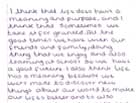

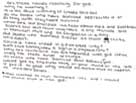
_thumb_tcm8-16975.jpg)
_thumb_tcm8-16976.jpg)
_thumb_tcm8-16977.jpg)
_thumb_tcm8-16978.jpg)
_medium_tcm8-17442.jpg)
_medium_tcm8-17443.jpg)
_medium_tcm8-17444.jpg)
_medium_tcm8-17445.jpg)
_thumb_tcm8-16979.jpg)
_thumb_tcm8-16980.jpg)
_thumb_tcm8-16981.jpg)
_medium_tcm8-17446.jpg)
_medium_tcm8-17447.jpg)
_medium_tcm8-17448.jpg)
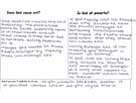
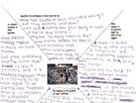


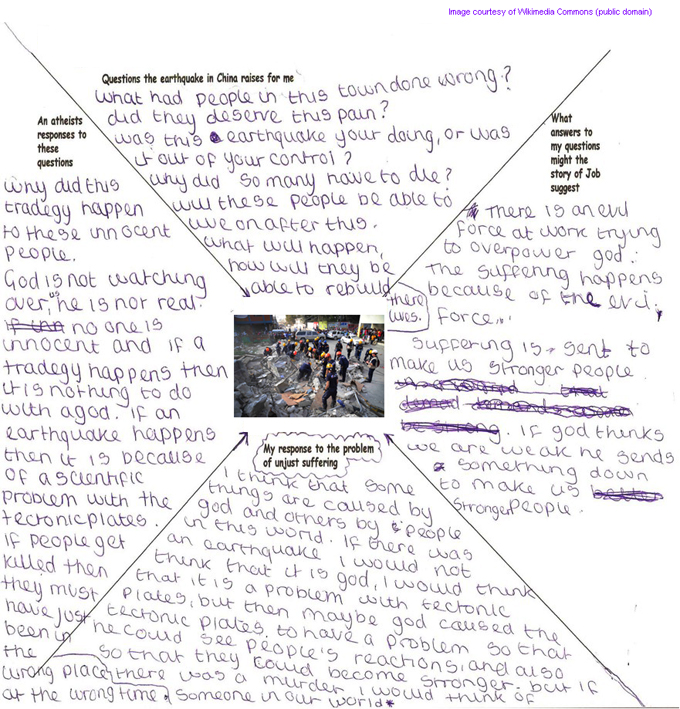
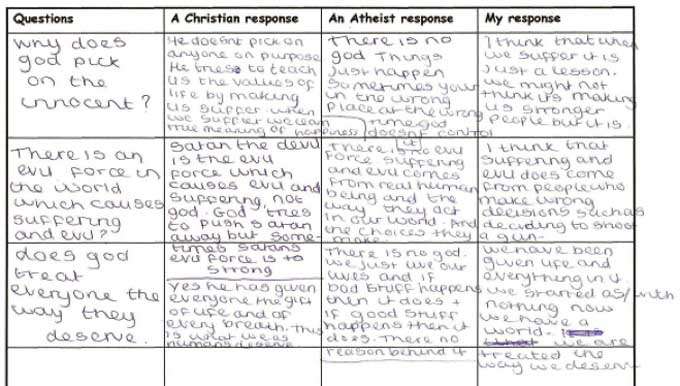
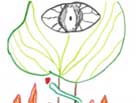
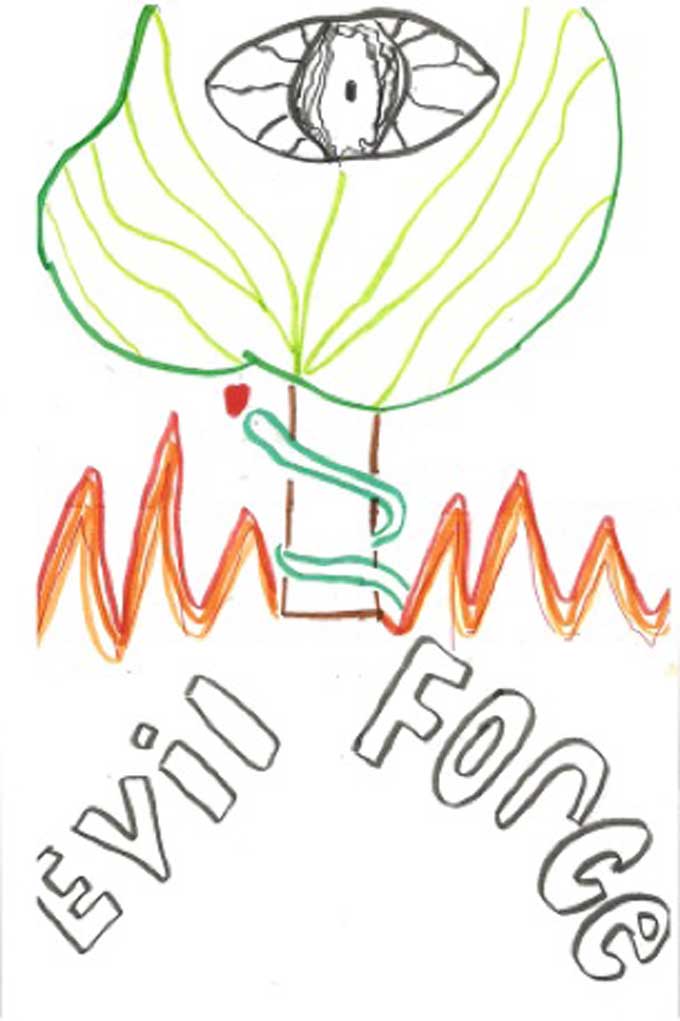
_thumb_tcm8-16986.jpg)
_thumb_tcm8-16987.jpg)
_medium_tcm8-17453.jpg)
_medium_tcm8-17454.jpg)
Assessment Commentary
Pupil D's written work shows a breadth of understanding as she expresses three insights into the meaning of life and raises a range of religious and other questions about the challenges of suffering from natural disasters. She has adapted these ideas from the class and paired discussions and her own reflections in times of silence. She responded well to this activity, saying that she enjoyed the freedom to ask questions to 'expand her thinking'.
Enquiring, investigating and interpreting:
The 11 questions Pupil D raised cover several disciplines, including philosophy and theology. Her questions initiate three lines of enquiry: the practical facts of the earthquake, Christian responses to evil and natural disaster, and the responses of survivors to the disaster. She has thought about the challenges that natural disasters can pose when considering the meaning and purpose of life. Her questions show she has interpreted the significance of an image of suffering for herself.
Reflecting, evaluating and communicating:
Pupil D has handled a variety of ideas relating to family, discovery and the purpose of difficult times in life. While the work does not make explicit reference to religious materials, Pupil D has shown she can develop insights of her own into questions of commitment. Her spoken comments show she recognises how debate and discussion can help to develop or 'create' new ideas.